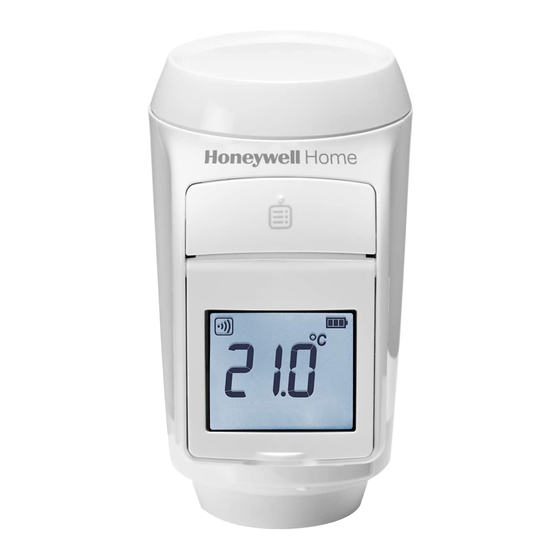
Table of Contents
Advertisement
HR92
Radiator Controller
1. Scope of delivery
The radiator controller packaging contains:
1
1 Radiator controller with valve baseplate M30 x 1.5;
batteries included
2 Display support
3 Valve adapter type Danfoss RA
4 Screws for securing radiator controller and battery
compartment
Danger of suffocation!
f Keep packaging materials away from
children.
WARNING
Wireless
2
4
3
re 2. Brief description
The HR92UK radiator controller is certified
by eu.bac.
214431
HR92 is an electronic radiator controller with a modern
design. Because of the wireless communication with
a frequency of 868 MHz the controller can be easily
integrated in heating systems such as evohome to
control the room temperature.
User-friendly
• Large adjustable display with backlight.
• Display of information in the display using symbols
and text.
• Parameters can be set individually.
• Manual temperature modification (effective until the
next switching point) possible at any time.
Mounting
• The radiator controller fits on the most common
radiator valves of the type M30x1.5.
• Further adapters are available as accessories.
• An external window contact can be connected
optionally.
Energy saving features
• With the window function, the radiator valve is closed
when ventilating the room.
• If an external window contact is used, the radiator
valve is closed when a window is open.
f Use the radiator controller only in
accordance with these operating
instructions.
CAUTION f Do not let children play with the radiator
controller.
UK
1
Advertisement
Table of Contents

Summary of Contents for Honeywell Home HR92UK
- Page 1 2. Brief description The HR92UK radiator controller is certified by eu.bac. 214431 HR92 is an electronic radiator controller with a modern design. Because of the wireless communication with a frequency of 868 MHz the controller can be easily integrated in heating systems such as evohome to control the room temperature.
-
Page 2: Device Overview
Radio signal display 3. Device overview Display Meaning Operating elements and display Field strength excellent Field strength good Field strength weak 4. Mounting Ready to operate in three steps: • Insert batteries and set language • Establish radio connection 1 Adjustment dial •... - Page 3 The language selection is only displayed during initial commissioning. The battery life of new alkaline cells amounts to approx. 2 years. The batteries need changing when the symbol flashes. All the settings are retained when the batteries are changed. Explosion hazard! f Never charge non rechargeable batteries.
-
Page 4: Radio Test
Binding at the HR92 Radio test 1. Press the button briefly. The radio symbol flashes during binding. If binding was successful, success is displayed. 2. Hold the button pressed for 5 seconds. Afterwards the main display is shown. 3. Select rf check using the adjustment dial and When... - Page 5 Interrupting the radio test Selecting the adapter The radio test is terminated automatically after approx. The radiator controller fits on common radiator valves 10 minutes. of the type M30 x 1.5. Adapters are required for some – or – valve types. fSelect exit using the adjustment dial and confirm...
-
Page 6: Mounting The Radiator Controller
Mounting the valve baseplate 3. Lock the radiator controller in the end position. To do so, push the slide towards After approx. 1 minute cycl (self-test) is displayed. Afterwards the radiator controller changes to normal operation. °C 1. Separate the valve baseplate from the radiator The radiator controller only operates if it is locked correctly in the end position. -
Page 7: Cable Connection
Securing the radiator controller Connecting an external window contact The floating external window contacts HCA30 can be The radiator controller and the batteries can be connected to the HR92 radiator controller. secured against removal by using the supplied screws. The cable ACS90 is required to connect the external window contact. -
Page 8: Changing Parameters
5. Basic settings Set- Par. Meaning ting Battery type Overview Alkaline Lithium If required, the 12 basic settings (parameters) can be NiMH (rechargeable batteries) adjusted. Display of the valve position * Factory settings have a grey background. No display of the valve position Parameters marked with an * are described in more Momentary display of the valve position detail below. -
Page 9: Further Functions
Description of the parameters Parameter 10 – Display of the valve position When this parameter is activated (setting "1"), the calculated valve position (0 ... 100% opened) is Parameter 2 – Backlight displayed momentarily. The display has a backlight for reading the information. The main display is shown again after approx. -
Page 10: Window Function
7. Help with problems Automatic monitoring functions Window function If you open a window causing the temperature to drop, Error table the radiator controller closes the radiator valve in order to save energy. Problem/ is displayed. window Cause Remedy Display When the temperature rises again, but at the latest after flashing Batteries flat Replace the batteries. -
Page 11: Emergency Operation When Batteries Are Flat
The binding is retained. HR92UK 10. Declaration of Conformity Type IP30 Protection class Hereby Honeywell Home es that this HR92UK is in Radio communication SRD (868.0 ... 870.0 MHz) ntial requirements and other compliance with the ess RX Class 2 relevant provisions of Di ective 1999/5/EC. - Page 12 * Only at operating devices with 2-way communication, e.g. evotouch. Ademco 1 GmbH @2020 Resideo Technologies, Inc. All Hardhofweg 40 rights reserved. The Honeywell Home 74821 Mosbach trademark is used under license from Phone: +49 1801 466 388 Honeywell International Inc. This info.de@resideo.com...













Need help?
Do you have a question about the HR92UK and is the answer not in the manual?
Questions and answers